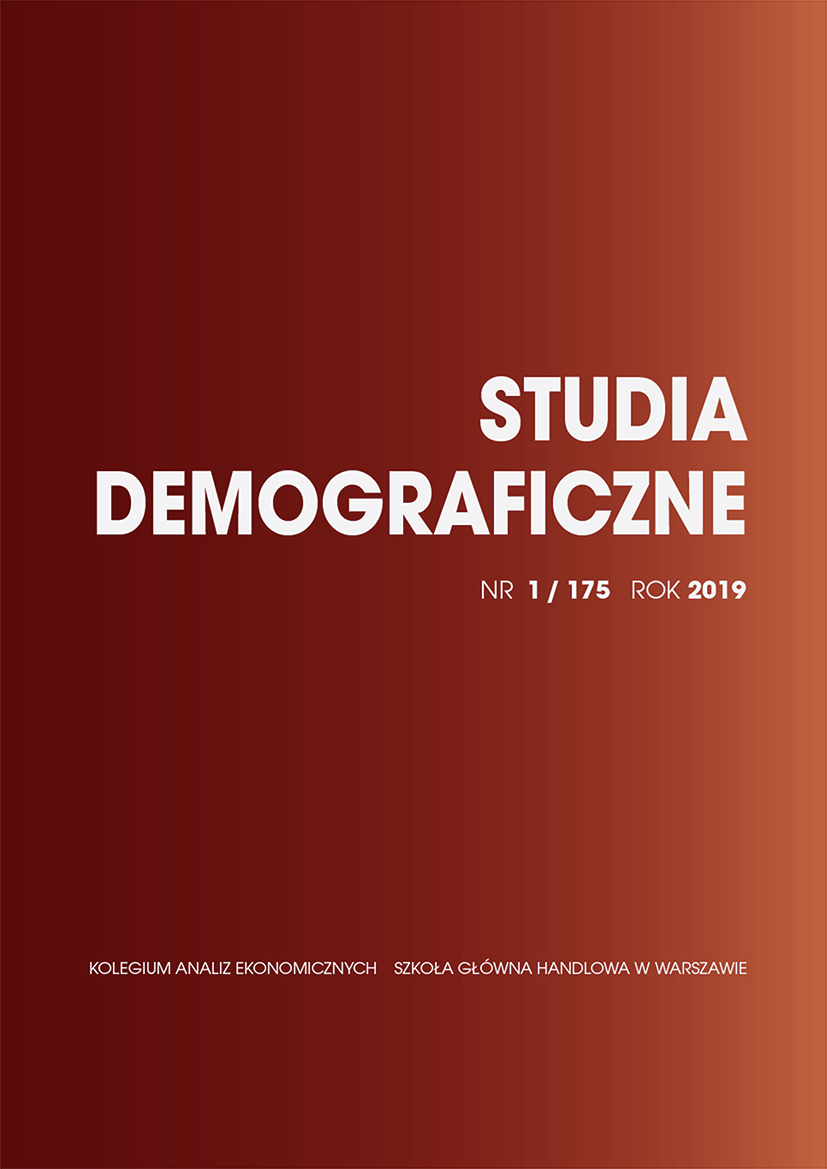Life expectancy and lifespan inequality: a perfect linear correlation? Analysis of the relationship with a particular emphasis on the case of countries going through the life expectancy stagnation period
Main Article Content
Abstract
In recent years in demography there has been a growing discussion about the relationship between life expectancy and lifespan inequality. It appears that in the long run this relationship tends to be strongly linear – countries with the longest life expectancy are also the most equal. This article takes a closer look at countries that went through long periods of life expectancy stagnation and shows that during those times they also experienced a reduction in inequality, mainly due to a large decrease in infant mortality. However, if only adult mortality is taken into account inequality was stagnating or even rising in many cases. Particularly interesting is the fact that a similar pattern of the relationship between life expectancy and lifespan inequality was observed both in Eastern or Western Europe.
Article Details
References
[2] Aburto, J. M., Wensink, M., van Raalte, A., & Lindahl-Jacobsen, R. (2018). Potential gains in life expectancy by reducing inequality of lifespans in Denmark: An international comparison and cause-of-death analysis. BMC Public Health, 18 (1), 831.
[3] Aburto, J. M., & van Raalte, A. (2018). Lifespan dispersion in times of life expectancy fluctuation: The case of Central and Eastern Europe. Demography, 55, 2071–2096.
[4] Colchero, F., Rau, R., Jones, O. R., Barthold, J. A., Conde, D. A., Lenart, A., Nemeth, L., Scheuerlein, A., Schoeley, J., Torres, C., Zarulli, V., Altmann, J., Brockman, D. K., Bronikowski, A. M., Fedigan, L. M., Pusey, A. E., Stoinski, T. S., Strier, K. B., Baudisch, A., Alberts, S. C., & Vaupel, J. W. (2016). The emergence of longevous populations. Proceedings of the National Academy of Sciences of the United States of America, 113 (48).
[5] HMD (2019). Human Mortality Database. Berkeley, USA: University of California, Germany: Max Planck Institute for Demographic Research.
[6] Hummer, R. A., & Hernandez, E. M. (2013). The effect of educational attainment on adult mortality in the United States. Population Bulletin, 68 (1), 1–16.
[7] Lindahl-Jacobsen, R., Oeppen, J. E., Rizzi, S., Möller, S., Zarulli, V., Christensen, K., & Vaupel, J. W. (2016). Why did Danish women life expectancy stagnate? The influence of interwar generations’ smoking behavior. European Journey of Epidemiology, 31 (12).
[8] McKee, M., & Shkolnikov, V. M. (2001). Understanding the toll of premature death among men in eastern Europe. BMJ, 323 (7320), 1051–5.
[9] Mesle, F. (2004). Mortality in Central and Eastern Europe: Long-term trends and recent upturns. Demographic Research, S2.3, 45–70.
[10] Missov, T. I., Lenart, A., Nemeth, L., Canudas-Romo, V., & Vaupel, J. W. (2015). The Gompertz force of mortality in terms of the modal age at death. Demographic Research, 32 (36), 1031–1048.
[11] Németh, L. (2017). Life expectancy versus lifespan inequality: A smudge or a clear relationship? PloS One, 12 (9).
[12] OECD (2017). Inequalities in longevity by education in OECD countries, Paris: OECD Publishing. Shkolnikov, M., & Andreev, E. (2010). Spreadsheet for calculation of life-table dispersion measures, MPIDR Technical Report.
[13] Van Raalte, A. A., & Caswell, H. (2013). Perturbation analysis of indices of lifespan variability. Demography, 50, 1615.
[14] Vaupel, J. W., Zhang, Z., & van Raalte, A. (2011). A life expectancy and disparity: An international comparison of life table data. BMJ Open, 1.
[15] Wróblewska, W. (2017). Pomiar dyspersji wieku w momencie zgonu. Przyczynek do analizy kompresji umieralności w Polsce. Studia Demograficzne, 1 (171).
